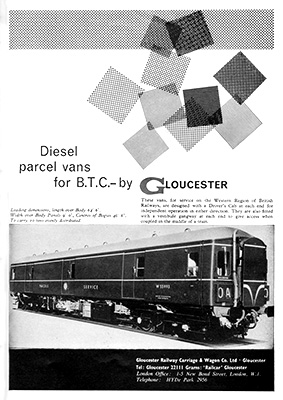Class 128 Gloucester RC&W Parcel DMU Cars
Description

The underframes and bogies were based on the standard Derby design, the frame being a welded fabrication of rolled-steel channel sections. Rubber springs were incorporated in the Garrington buffers. Bogies were of the swing-bolster type with hydraulic dampers (supplied by Jonas Woodhead & Sons Ltd) for bolster side control.
The bodies were of an all-steel welded construction using 16 gauge sheet for the bodyside and roof panels and 3/8 inch thick material for the bodyside pillars
There were three double sliding doors on each side, each was fitted with a drop light on the right hand side. The top-hung heavy duty sliding door gear was supplied by Beclawat. Roof stiffening arches were incorporated at both ends of each of the door frames.
Equipment
Each vehicle had two Leyland Albion 6-cylinder RE901 engines rated 238hp at 1,900rpm. The drive was taken through a fluid flywheel and SCG type SE4 four-speed epicyclic gearbox to a RF28 final drive in the inner axle of each bogie. The mountings of the engine and transmission units and the cooling arrangements were standard to other DMUs. Graviner fire protection equipment was fitted over the power units, and water and CO2 hand extinguishers were carried in each cab.
There were two 80 gallon frame mounted rectangular fuel tanks, one of which also supplied diesel to the heater. This capacity gave a fuel range of approximately 350 miles. Battery charging was by an engine driven 24V 75A CAV alternators and rectifier, the lead-acid battery being of 440 Ah capacity.
The standard Gresham & Craven quick release brakes were fitted, and there was a hand-parking brake in each of the guards compartments.
Driven from an axlebox was a Smith-Stone speed indicator and distance counter. Western Region automatic train control and sanding equipment was fitted on the WR cars. Provision was made on the LMR vehicles for the later installation of AWS equipment.
In later years some of the cars received Leyland TL11 power units.
Interior

The body was asbestos insulated and lined with 3/8 inch plywood and the composition floor was laid with Flintkote Indasco. The floor area in front of the doorways had chequered dumping plates recessed flush with the floor level.
Hinged racks for small parcels, a letter rack, and straps for securing bikes (including motorcycles) were fitted at each end. Lighting was by seven 60W roof lamps in the van and 15W lamps in driver and guards compartments. Dust traps were fitted in the BR standard roof ventilators. In the LMR cars were drain holes in the floor, and in the WR cars was a storage area for the gangway blank door for when in multiple.
Crew areas
The cab at each end was divided to provide a complete enclosure for the driver and a compartment, with access to the van, for the guard. The internal layout was identical with both cab types, the lack of gangway on the Midland cars did not mean a full width cab.
On the flat-top knee-hole drivers desk were mounted the driving controls and light switches, and vertically mounted on the front bulkhead were the instruments and gauges. AW Chapman Limited supplied were standard adjustable upholstered seats for the driver, and a drop seat for the guard. An electric food warmer was recessed into the bulkhead of one cab. One Smiths combustion heater was fitted for cab heating and through train heating controls were fitted in the guard's compartment. Loudaphone equipment was installed for communication between driver and guard. The cab doors, supplied by Lightalloys. Limited, were all fitted with Beclawat balanced drop lights. Trico - Forbeth screen wipers, sun visors and Smiths de-misters were fitted, and on the LMR cars there were hand operated screen washers.


The first image shows the drivers compartment of a new gangwayed vehicle. The numbered items are:
- Air pressure gauge
- Vacuum Gauge — Train And Release Pipe
- Speedometer
- Engine Speed Indicator
- Dimmer Switch — Panel Lights
- Head Code Roller Blind Handles
- Main Switch Light Indicator
- Route Head Code Indicator Light Switch
- Panel Lighting Switch
- Engine Speed Indicator Change-Over Switch
- Throttle Controller
- Buzzer Button
- Demister Switch
- Main Key Switch
- Gearbox Controller
- Horn Lever
- Windscreen Wiper Valve
- Sanding Button
- Driver's Brake Valve
- Guard's Emergency Brake Valve
- Cab Light Switch
- Deadman's Cancellation Button
- Vacuum Gauge — Train Pipe
- Vacuum Gauge — No.1 and No.2 Vacuum Cylinders
The second image shows the cab of a gangwayed Class 128, thought to be 55992 taken at Vic Berry's on 2-11-88. Michael Kaye 55A.
Dimensions
Length over buffers 67' 1"
Width over body 9' 0"
Height over roof panels 12' 4 1/2"
Length of luggage compartment 55' 3 7/8"
Bogie centres 46' 6"
Bogie wheelbase 8' 6"
Wheel diameter 3' 0"
Weight in working order 40 tons
Pay load - distributed 10 tons
Test load - distributed 18 tons
Fuel capacity 160 gallons
Buffers
All vehicles had 'cut' buffers when new, other styles would be carried through the years. A survey of photos shows:
55987 round by 1966
55988 round circa 1971
55989 oval by 1964, round by 1979
55990 oval by 1968, round by 1977
55991 round by 1975
55992 oval by 1969, round by 1971
55993 oval by 1969
55994 cut till withdrawal
55995 oval non-exhaust end only by 1975
55996 round early 1970s
55995 ran with a square cut one on one side and oval on the other in 1967.
Gangways
Only the six cars delivered the Western Region (55991 - 6) were fitted with suspended type gangways for through access, the London Midland Region cars (55987 - 90) were non-gangwayed and would have an extra window on the cab front. At least 55993 of the WR batch had brackets for taking small destination boards below the cab windows. In a publicity shot of this vehicle it is displaying 'Wellington', and was green with white/cream lettering (all upper case).
In 1979/80 the LMR removed the gangways from the four ex-WR vehicles it had obtained. Newton Heath allocated 55996 seems to have been the first, but would be withdrawn shortly afterwards. The other three were Chester based 55993/4/5.
The other two 55991/2 would keep their gangways till withdrawal.
Some also had the headcode boxes removed, plated over and a marker lights fitted. At least 55990 ran with the centre two characters blanked of in yellow and the two outer ones left black with white dots.
Summary
Description
Diagrams & Works Pics
Numbering & Driving Inst.
Liveries
Operations
Images
No Class 128 vehicles were preserved.


